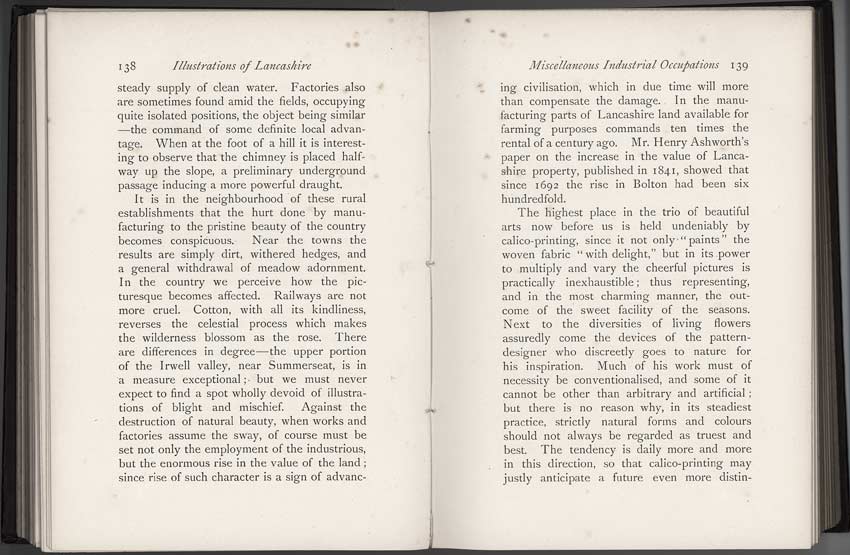138 Illustrations of Lancashire
steady supply of clean water. Factories also are sometimes found amid the fields, occupying quite isolated positions, the object being similar - the command of some definite local advantage. When at the foot of a hill it is interesting to observe that the chimney is placed half-way up the slope, a preliminary underground passage inducing a more powerful draught.
It is in the neighbourhood of these rural establishments that the hurt done by manufacturing to the pristine beauty of the country becomes conspicuous. Near the towns the results are simply dirt, withered hedges, and a general withdrawal of meadow adornment. In the country we perceive how the picturesque becomes affected. Railways are not more cruel. Cotton, with all its kindliness, reverses the celestial process which makes the wilderness blossom as the rose. There are differences in degree - the upper portion of the Irwell valley, near Summerseat, is in a measure exceptional; but we must never expect to find a spot wholly devoid of illustrations of blight and mischief. Against the destruction of natural beauty, when works and factories assume the sway, of course must be set not only the employment of the industrious, but the enormous rise in the value of the land; since rise of such character is a sign of advanc-
|
Miscellaneous Industrial Occupations 139
ing civilisation, which in due time will more than compensate the damage. In the manufacturing parts of Lancashire land available for farming purposes commands ten times the rental of a century ago. Mr. Henry Ashworth's paper on the increase in the value of Lancashire property, published in 1841 showed that since 1692 the rise in Bolton had been six hundredfold.
The highest place in the trio of beautiful arts now before us is held undeniably by calico-printing, since it not only "paints" the woven fabric "with delight," but in its power to multiply and vary the cheerful pictures is practically inexhaustible; thus representing, and in the most charming manner, the outcome of that sweet facility of the seasons. Next to the diversities of living flowers assuredly come the devices of the pattern designer who discreetly goes to nature for his inspiration. Much of his work must of necessity be conventionalised, and some of it cannot be other than arbitrary and artificial; but there is no reason why, in its steadiest practice, strictly natural forms and colours should not always be regarded as truest and best. The tendency is daily more and more, in this direction, so that calico-printing may justly anticipate a future even more distin-
|

